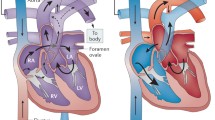Abstract
With Patent Foramen Ovale occurring in 20–25 % of the adult population, it can often be discovered incidentally during a cardiac evaluation. How should these patients be counseled? Is further evaluation warranted to assess risk factors that may predict a future complication? Is treatment of any sort needed?
Access this chapter
Tax calculation will be finalised at checkout
Purchases are for personal use only
Similar content being viewed by others
References
Hagan PT, Scholz DG, Edwards WD. Incidence and size of patent foramen ovale during the first 10 decades of life: an autopsy study of 965 normal hearts. Mayo Clin Proc. 1984;59(1):17–20.
Yahia AM, Shaukat A, Kirmani JF, Qureshi AI. Age is not a predictor of patent foramen ovale with right-to-left shunt in patients with cerebral ischemic events. Echocardiography. 2004;21:517–22.
Di Tullio MR, Jin Z, Russo C, Elkind MSV, Rundek T, Yoshita M, et al. Patent foramen ovale, subclinical cerebrovascular disease, and ischemic stroke in a population-based cohort. J Am Coll Cardiol. 2013;62:35–41.
Meissner I, Khandheria BK, Heit JA, Petty GW, Sheps SG, Schwartz GL, et al. Patent foramen ovale: innocent or guilty? Evidence from a prospective population-based study. J Am Coll Cardiol. 2006;47:440–5.
Fenster BE, Nguyen BH, Buckner JK, Freeman AM, Carroll JD. Effectiveness of percutaneous closure of patent foramen ovale for hypoxemia. Am J Cardiol. 2013;112(8):1258–62.
Hoffmann A, Chockalingam P, Balint OH, Dadashev A, Dimopoulos K, Engel R. Cerebrovascular accidents in adult patients with congenital heart disease. Heart. 2010;96:1223–6.
Fischbein CA, Rosenthal A, Fischer EG, Nadas AS, Welch K. Risk factors of brain abscess in patients with congenital heart disease. Am J Cardiol. 1974;34:97–102.
Nanthakumar K, Graham AT, Robinson TI, Grande P, Pugash RA, Clarke JA, et al. Contrast echocardiography for detection of pulmonary arteriovenous malformations. Am Heart J. 2001;141:243–6.
Pfleger S, Konstantin Haase K, Stark S, Latsch A, Simonis B, Scherhag A, et al. Haemodynamic quantification of different provocation manoeuvres by simultaneous measurement of right and left atrial pressure: implications for the echocardiographic detection of persistent foramen ovale. Eur J Echocardiogr. 2001;2:88–93.
Torti SR, Billinger M, Schwerzmann M, Vogel R, Zbinden R, Windecker S, Seiler C. Risk of decompression illness among 230 divers in relation to the presence and size of patent foramen ovale. Eur Heart J. 2004;25:1014–20.
Barone DA, Krieger AC. Stroke and obstructive sleep apnea: a review. Curr Atheroscler Rep. 2013;15:334–8.
Johansson MC, Eriksson P, Peker Y, Hedner J, Rastam L, Lindblad U. The influence of patent foramen ovale on oxygen desaturation in obstructive sleep apnoea. Eur Respir J. 2007;29:149–55.
Ciccone A, Proserpio P, Roccatagliata DV, Nichelatti M, Gigli GL, Parati G, et al. Wake-up stroke and TIA due to paradoxical embolism during long obstructive sleep apnoeas: a cross-sectional study. Thorax. 2013;68:97–104.
Cushman M. Inherited risk factors for venous thrombosis. Hematology. 2005;44:452–7.
Habe K, Wada H, Matsumoto T, Ohishi K, Ikejiri M, Matsubara K, et al. Presence of antiphospholipid antibody is a risk factor in thrombotic events in patients with antiphospholipid syndrome or relevant diseases. Int J Hematol. 2013;97(3):345–50.
Rott H. Thrombotic risks of oral contraceptives. Curr Opin Obstet Gynecol. 2012;24:235–40.
James AH. Pregnancy-associated thrombosis. Hematology. 2009;1:277–85.
Ng SY, Sugarbaker DJ, Frendl G. Interatrial shunting after major thoracic surgery: a rare but clinically significant event. Ann Thorac Surg. 2012;93:1647–51.
Roberge S, Nicolaides KH, Demers S, Villa P, Bujold E. Prevention of perinatal death and adverse perinatal outcome using low-dose aspirin: a meta-analysis. Ultrasound Obstet Gynecol. 2013;41(5):491–9.
Barrack RL. Current guidelines for total joint VTE prophylaxis: dawn of a new day. J Bone Joint Surg Br. 2012;94(11 Suppl A):3–7.
O’Neill VJ, Jeffrey Evans TR, Preston J, Moss J, Kaye SB. A retrospective analysis of Hickman line-associated complications in patients with solid tumours undergoing infusional chemotherapy. Acta Oncol. 1999;38:1103–7.
DeSimone CV, Friedman PA, Noheria A, Patel NA, DeSimone DC, Bdeir A, et al. Stroke or transient ischemic attack in patients with transvenous pacemaker or defibrillator and echocardiographically detected patent foramen ovale. Circulation. 2013;128(13):1433–41.
Parsi K. Paradoxical embolism, stroke and sclerotherapy. Phlebology. 2012;27:147–67.
Carroll JD, Saver JL, Thaler DE, Smalling RW, Berry S, MacDonald LA, et al. Closure of patent foramen ovale versus medical therapy after cryptogenic stroke. N Engl J Med. 2013;368:1092–100.
Mas JL, Arquizan C, Lamy C, Zuber M, Cabanes L, Derumeaux G, Coste J, Patent Foramen Ovale and Atrial Septal Aneurysm Study Group, et al. Recurrent cerebrovascular events associated with patent foramen ovale, atrial septal aneurysm, or both. N Engl J Med. 2001;345(24):1740–6.
Rigatelli G, Dell’Avvocata F, Cardaioli P, Giordan M, Braggion G, Aggio S, et al. Permanent right-to-left shunt is the key factor in managing patent foramen ovale. J Am Coll Cardiol. 2011;58:2257–61.
Schuchlenz HW, Saurer G, Weihs W, Rehak P. Persisting eustachian valve in adults: relation to patent foramen ovale and cerebrovascular events. J Am Soc Echocardiogr. 2004;17:231–3.
Rigatelli G, Dell’avvocata F, Braggion G, Giordan M, Chinaglia M, Cardaioli P. Persistent venous valves correlate with increased shunt and multiple preceding cryptogenic embolic events in patients with patent foramen ovale: an intracardiac echocardiographic study. Catheter Cardiovasc Interv. 2008;72:973–6.
Krasuski RA, Hart SA, Allen D, Qureshi A, Pettersson G, Houghtaling PL, et al. Prevalence and repair of intraoperatively diagnosed patent foramen ovale and association with perioperative outcomes and long-term survival. JAMA. 2009;302(3):290–7.
Furlan AJ, Reisman M, Massaro J, Mauri L, Adams H, Albers GW, Felberg R, et al. Closure or medical therapy for cryptogenic stroke with patent foramen ovale. N Engl J Med. 2012;366(11):991–9.
Meier B, Kalesan B, Mattle HP, Khattab AA, Hildick-Smith D, Dudek D, et al. Percutaneous closure of patent foramen ovale in cryptogenic embolism. N Engl J Med. 2013;368(12):1083–91.
Author information
Authors and Affiliations
Corresponding author
Editor information
Editors and Affiliations
Rights and permissions
Copyright information
© 2015 Springer-Verlag London
About this chapter
Cite this chapter
Sommer, R.J., Spencer, B.T. (2015). When a PFO Is Discovered Incidentally. In: Amin, Z., Tobis, J., Sievert, H., Carroll, J. (eds) Patent Foramen Ovale. Springer, London. https://doi.org/10.1007/978-1-4471-4987-3_16
Download citation
DOI: https://doi.org/10.1007/978-1-4471-4987-3_16
Published:
Publisher Name: Springer, London
Print ISBN: 978-1-4471-4986-6
Online ISBN: 978-1-4471-4987-3
eBook Packages: MedicineMedicine (R0)




